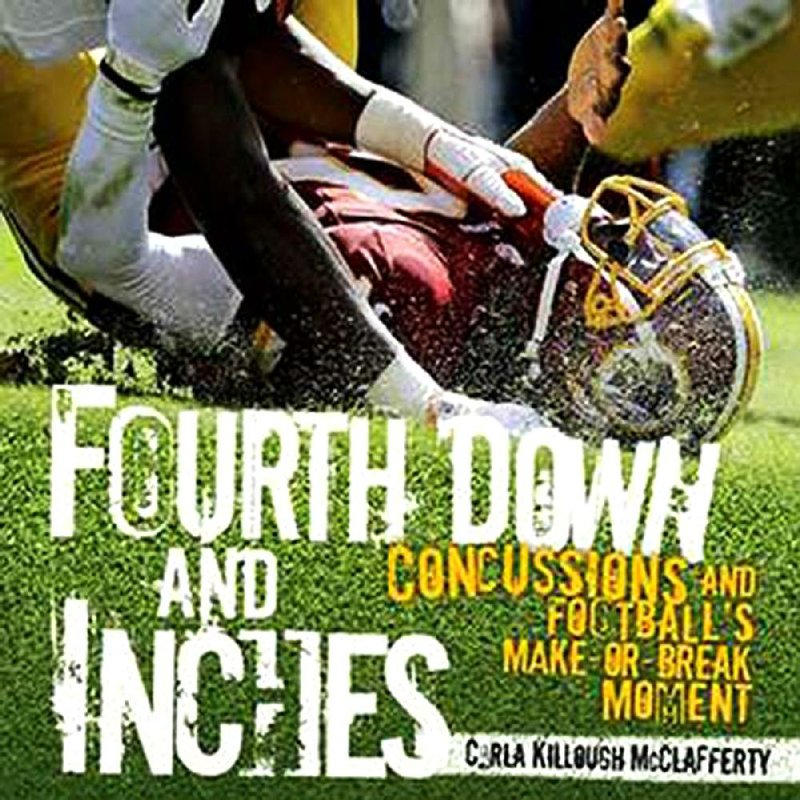The subject of Benton author Carla McClafferty’s new book for young readers hit harder than she expected.
Fourth Down and Inches: Concussions and Football’s Make-or-Break Moment (Carolrhoda Books, 96 pages, $20.95) is a history and explanation of head injuries related to the game.
“I would not call myself a sports person,” McClafferty says. “But I do have a connection in the way my son died from a head injury.”
McClafferty lost her 14-month-old son, Corey, to a combination she describes as “two minor falls.” She wrote her first book, Forgiving God (2000), about her spiritual struggle to accept the loss. But her research on football concussions helped her understand what happened physically.
The first fall caused a concussion, a brain injury. The damage takes time to heal. Another hit on the head, too soon in the healing process, can bring about a rare but often fatal consequence: “second impact syndrome.”
“It happens to football players every year,” she writes, and she talked with parents who had lost their children to head injuries.
“I could tell them I grieved just as they were grieving,” McClafferty says. “I told them I would give their sons the same respect and love as I did my own.”
“Head ringer” was the old football term for a concussion, and players were expected to shake off the woozies. Today’s science and medicine recognize the danger of a serious injury.
Why play? Considering the risk, why do parents allow their children to play football?
McClafferty asked National Football League running back Kevin Turner to explain his passion for the game. Turner describes the giddy thrill of his first professional touchdown.
The memory brought tears to the eyes of this “6-feet-1-inch, 230-pound fearless athlete,” McClafferty writes.
Turner couldn’t count the number of likely concussions he sustained in his career - times when he “saw stars.” Except for the two times he was knocked out, he says in the book, “I probably didn’t say anything.”
Later diagnosed with Lou Gehrig’s disease, he blamed the nerve dysfunction on knocks to the head. He was a key figure in this month’s settlement, in which the NFL agreed to pay millions to retired athletes claiming brain injuries.
“It’s a rough, rough, rough game,” McClafferty says. But some guys like to play rough,and throngs of fans pay to see the rumble-tumble excitement.
The book tells one case in which a mother set aside her own heartbreak to defend the game that took her son’s life. In fact, she made history.
Von Gammon played for the University of Georgia in 1897, McClafferty writes. His death after suffering a concussion nearly ended the game in its formative years.
“Death Knell of Football,” the Atlanta Constitution described the aftermath. The Legislature voted to ban football, and the bill awaited only the governor’s signature. The governor asked Gammon’s mother what to do.
She said her son’s death “should not be used to defeat the most cherished object in his life,” the game of football.
The triumphs and tragedies of football have been at odds ever since. The book describes new findings, and tells how protective gear has improved since the old days of little or no padding at all.
Modern hard-plastic helmets are designed to prevent skull fractures, McClafferty says, but “football helmets are very unlikely to prevent all concussions.”
Her five previous children’s books are about George Washington and Marie Curie, among other historical figures. A former radiologic technologist, she wrote a book about X-rays.
She did not imagine wanting to write about head injuries, she says, but took up her editor’s challenge to write Fourth Down and Inches as a balanced view of a difficult subject.
“I write in a simple way,” McClafferty says, “but I write about very complex things.”
The book is square like a picture story, and a bright sixth-grade reader should be able to handle the vocabulary, she expects, “but it’s no baby book.”
She describes research at the Center for the Study of Traumatic Encephalopathy (brain damage) in Boston, complete with a photo of brains in jars.
“My goal is that a reader who does not know anything about the subject will not only understand it, but will get it the first time,” McClafferty says.
In particular, she imagines the book in the hands of a young football player. It lists the symptoms of a concussion, including headache, dizziness, blurred vision, ringing in the ears, confusion, trouble remembering.
Football players pride themselves on being invulnerable, and “don’t want to lose their spot, don’t want to be a baby,” she says.
But maybe this boy, having read her book, will know “if you have a concussion, you can’t keep it a secret.”
Family, Pages 34 on 09/25/2013

